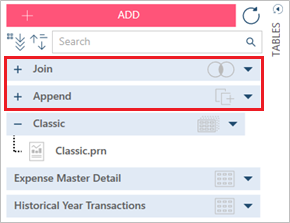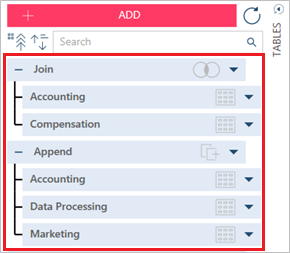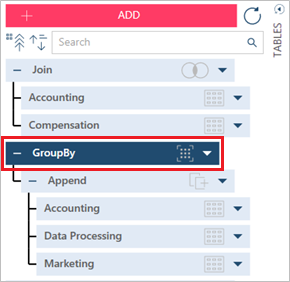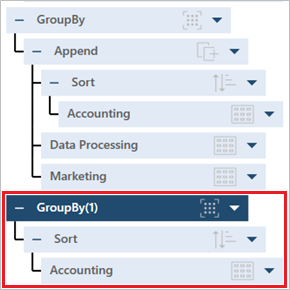Working with Load Plans
Load plans provide users with a hierarchical view of all of the operations performed on a table. This functionality allows users to easily track, modify, remove, and duplicate tables, especially those obtained through Transform and Combine operations.
In the table list below, for example, the tables Join and Append are the result of join and append operations, respectively.

In previous versions of Monarch Data Prep Studio, if you were to rename these tables, all information regarding their data sources and the operations performed to achieve the final table would be lost. Thus, should you wish to recreate the table at a later time, you would be unable to do so.
Load plans address this issue by marking joined, appended, or transformed
tables with a  sign to the left of the new table name and identifying the operation performed
to its right, e.g.:
sign to the left of the new table name and identifying the operation performed
to its right, e.g.:
|
Operation |
Icon |
|
|
|
|
|
|
|
|
|
|
|
|
|
|
|
|
|
|
|
Extract Rows |
|
|
|
|
|
|
Clicking on the  sign reveals the data sources of
our tables of interest:
sign reveals the data sources of
our tables of interest:

If we were to transform the table Append by grouping data, the resulting table will display on top of the Accounting, Data Processing, Marketing, and Append tables to indicate that a table with a new schema has been created from these three tables.

Thus, users are provided with a hierarchical view of all of the operations performed on a table; here, the most recent table is displayed at the top of the tree.
Note that load plans for sort operations behave differently from the load plans of other transformation operations. When a sort operation is applied to the Accounting table in the example above, the new sort table appears immediately over only the table of interest (i.e., the Accounting table), not the Group table, as might be expected with other transforms, and no new load plan is created.

This result is expected behavior because sorts do not change the schema of the original table.
When our sort definition is transformed by grouping, a new load plan is created, again because the schema of the resulting table (Group(1)) differs from that of the original table (Sort).

The first tables obtained through join, append, or transform operations are respectively named Join, Append, and <TransformationApplied> by default. The next tables obtained through these operations are sequentially named Join(1), Append(1), and <TransformationApplied(1)>. You can rename these tables by double-clicking on them in the Table List panel and then entering a new name in the field provided.











